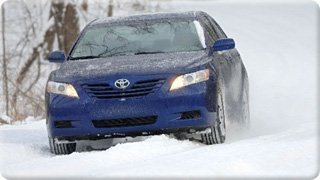 One third of
all new vehicles are sold with performance tires.
One third of
all new vehicles are sold with performance tires.
According to a market profile compilation by Tire Review, an industry trade magazine, the number of vehicles with OE (original equipment) tires containing a speed rating of H, V, or Z has doubled in the past five years. H, V, and Z rated tires are defined as performance, or ultra-high performance tires based on speed rating. In 2004, 17% of total vehicles shipped with tire speed ratings of H, V, or Z. In 2009, this number escalated to 34%. Clearly this represents a trend in which automobile manufacturers want to showcase their vehicles, especially to prospective buyers during the test drive.
Vehicle manufacturers want to showcase their automobiles at dealerships under the most favorable conditions. For this important reason, there has been a recent trend for new vehicles to ship with performance tires as original equipment. Automobile manufacturers want their vehicles to demonstrate precision handling, responsiveness, safety, and ride comfort – specifically during test drives. Including performance tires as OE is an attractive option to enhance the performance and handling during these test drives. There are a variety of performance tires which can help to achieve the desired results.
Because there’s been a proliferation of speed rated tires as OE on vehicles, it’s important that drivers are aware of what is on their vehicle. Many people assume they have all-season tires of some variety. The reality is 1 out of 3 new vehicles have performance tires which are designed for performance on dry pavement and summer conditions. Tires with speed ratings of H, V, or Z are not intended for use in snow, slush, or ice.
A Few things about performance tires:
First of all, they’re fantastic in warmer months, but they’re not designed to perform in cold temperatures. Performance tires are made of a rubber compound that is soft in warmer temperatures, but hardens in temperatures under 45 degrees, and cannot grip the road as well. They also have poor traction in ice, snow, and slush.
Secondly, they wear very quickly, some as fast as 15,000 miles, and they’re expensive to replace.
Many people don’t realize they have summer or performance tires on their vehicles – which could present a dangerous situation during the winter.
Tires are becoming a strategic component in helping to sell new vehicles. “Part of the reason for this is because tire comfort and tire performance directly correlate with the driver’s overall vehicle satisfaction. Original Equipment tires play an integral role in achieving the vehicle’s desired comfort and performance capabilities, and greatly influence the vehicle’s personality. And as vehicles have evolved, so have OE tires. For the most part, today’s vehicles are lighter, more fuel-efficient and more responsive than those built a decade ago. This has caused corresponding reductions in tire weight and rolling resistance, while enhancing the tire’s handling capabilities.”
“Each vehicle manufacturer prioritizes the areas that they feel are of greatest benefit to help their vehicles satisfy their drivers. For example, a vehicle manufacturer that offers a line of fuel-efficient vehicles may be able to place more emphasis on traction and less emphasis on lowering rolling resistance than a vehicle manufacturer that builds a line of larger, less fuel-efficient cars.”
“Only the vehicle manufacturer and tire manufacturer working together to develop the OE tire can determine exactly which tire design and internal construction will produce the most satisfactory results. A tire manufacturer who builds ‘all-purpose’ replacement tires will never receive the benefit of the vehicle manufacturer’s insight and intent, and is relegated to producing ‘average’ tires.”
So take a look at your tires. If you see an H, V, or Z speed rating, you should consider winter tires. Not only will you see improved traction, performance and handling in cold and winter conditions, but you will save precious tread wear on your speed rated performance tires, saving them for when they are designed to perform – in warm weather.
If you are unsure of your tires or their ability to handle winter conditions, we encourage you to stop into one of the convenient Dunn Tire locations. If you decide to buy winter tires, Dunn Tire offers a tire storage program to store your summer tires for you.
